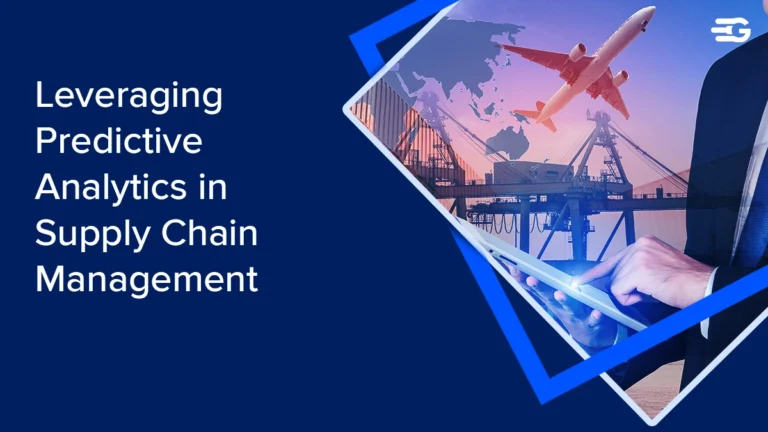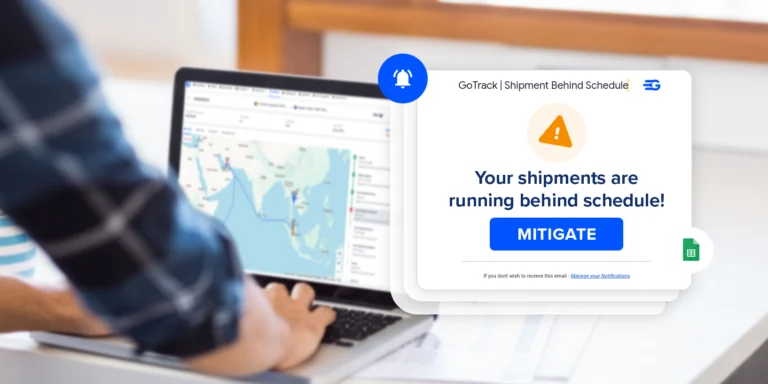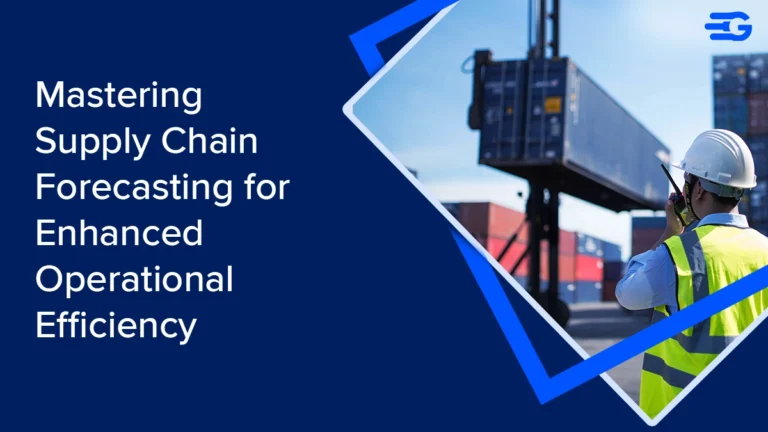Top 12 Supply Chain Planning Software in 2024
Supply chain planning is the backbone of business operations. With demand fluctuations, market changes, and increased customer expectations, efficient planning tools are essential. This blog explores the top supply chain planning software in 2024, highlighting their features and how they can make a difference in your business.
Criteria For Selecting a Supply Chain Planning Software
Choosing the right supply chain planning software depends on your company’s unique needs. Here are a few factors to keep in mind:
- Vendor Reputation: Read customer reviews and research the vendor’s reputation. A company with positive feedback and solid customer support can make a significant difference in your experience with the software.
- Functionality: Identify the specific functions your supply chain needs, such as demand forecasting or inventory optimization. Not all tools are equal in every function, so match the software’s strengths with your requirements.
- Ease of Use: A user-friendly interface can save time and ensure that teams make the most of the software. Consider software with intuitive dashboards and easy navigation.
- Data Management: Look for software that offers real-time visibility and advanced analytics. These features will help you make informed decisions quickly.
- Scalability: As your business grows, your supply chain needs will change. Choose software that can scale with your company, offering additional features or modules as needed.
- Cost and ROI: Evaluate the cost relative to the value the software will bring. While some platforms might seem expensive, the savings in time, accuracy, and efficiency can often justify the investment.
- Integration Capabilities: Check if the software integrates well with your existing systems, such as ERP or CRM platforms. Seamless integration ensures smooth data flow and reduces time spent on manual data transfers.
Best Supply Chain Planning Software
1. GoComet
GoComet offers a comprehensive, data-driven approach to managing and streamlining supply chains. Its standout features include real-time port congestion analysis and delay prediction tools that give businesses an edge in anticipating and managing potential shipment delays. GoComet’s intuitive platform combines automation with real-time tracking, allowing companies to stay on top of their logistics from end to end.
Users can also take advantage of cost-effective shipment management tools that help identify savings and optimize resources. With a user-friendly dashboard, GoComet enables clear, actionable insights for quicker decision-making, helping companies reduce costs, boost efficiency, and maintain operational transparency.
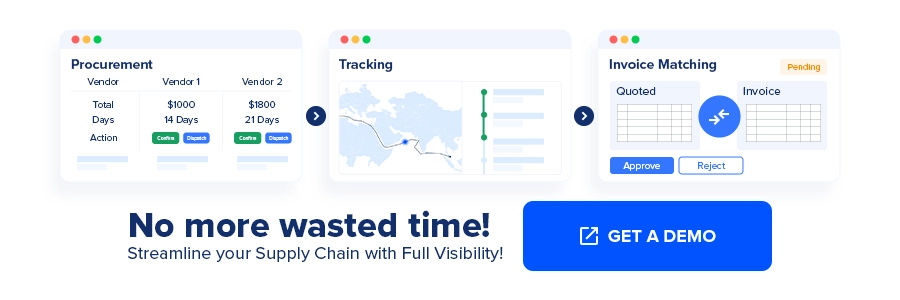
Key Features:
- Dynamic Route Optimization: Automates route planning with real-time data to ensure cost-effective and efficient freight movement.
- AI-Powered Freight Procurement: Uses AI to streamline vendor selection, optimize shipping modes, and reduce supply chain costs.
- Automated RFQ Management: Simplifies request-for-quote processes by automating vendor negotiations and enabling faster decision-making.
- Comprehensive Supply Chain Analytics: Delivers actionable insights into logistics performance, aiding in better supply chain planning.
Limitations:
- Limited SKU-Level Visibility: The system may not offer in-depth visibility at the SKU level, making it challenging for businesses to track and manage individual product performance effectively.
Ratings (as of December, 2024):
- G2: 4.8/5
- Capterra: 4.8/5
Customer Testimonial:
How GoComet Helped Transform This Global Brand’s Supply Chain
2. SAP
SAP’s supply chain planning software offers an integrated and intelligent approach to managing complex supply chain operations. With features like AI-powered demand forecasting, multi-echelon inventory optimization, and synchronized planning (xP&A), SAP enables businesses to build agile, risk-resilient, and sustainable supply chains.
Its comprehensive solutions, including SAP Integrated Business Planning (IBP) and SAP S/4HANA, enhance collaboration, optimize inventory, and improve decision-making, making it a top choice for enterprises aiming to stay competitive in a dynamic market.
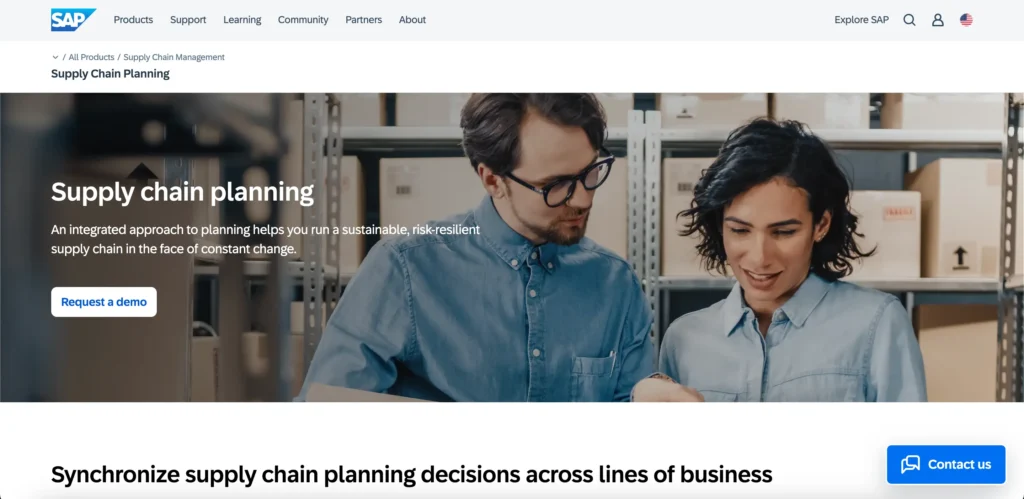
Key Features:
- Demand Forecasting with AI: Leverages machine learning and statistical modeling for accurate short- and long-term demand predictions.
- Integrated Planning (xP&A): Synchronizes supply chain decisions across financial and operational plans for real-time collaboration and agility.
- Inventory Optimization: Multi-echelon optimization to balance profitability while maintaining buffer stocks for unexpected demand.
- Advanced Supply Chain Analytics: Provides actionable insights through real-time data analysis, improving risk management and decision-making.
Limitations:
- High Complexity and Steep Learning Curve: Requires advanced technical expertise, with complex algorithms and challenging onboarding due to differences in data structures.
- Limited Flexibility and Integration Issues: Struggles with adopting new technologies, real-time integration with SAP ECC, and initial data formatting for optimal use.
Ratings (as of December, 2024):
- G2: 4.3/5
- Gartner: 4.3/5
Testimonials:
“Consultant team very difficult to work with, not open to share information or offer improvements. Design team (internal to SAP) has been responsive and helpful.”
3. Logility
Logility provides an AI-powered supply chain planning software designed to simplify and optimize operations. Its solutions focus on improving demand forecasting, inventory planning, and supplier collaboration. The platform uses advanced technologies like machine learning to enable faster and more accurate decision-making.
Businesses can rely on Logility to balance inventory levels, optimize resource allocation, and plan effectively for future demand. The platform’s tools make it easier to manage complex supply chains while minimizing risks and enhancing productivity. It also facilitates real-time collaboration across teams, ensuring alignment in supply and demand planning.
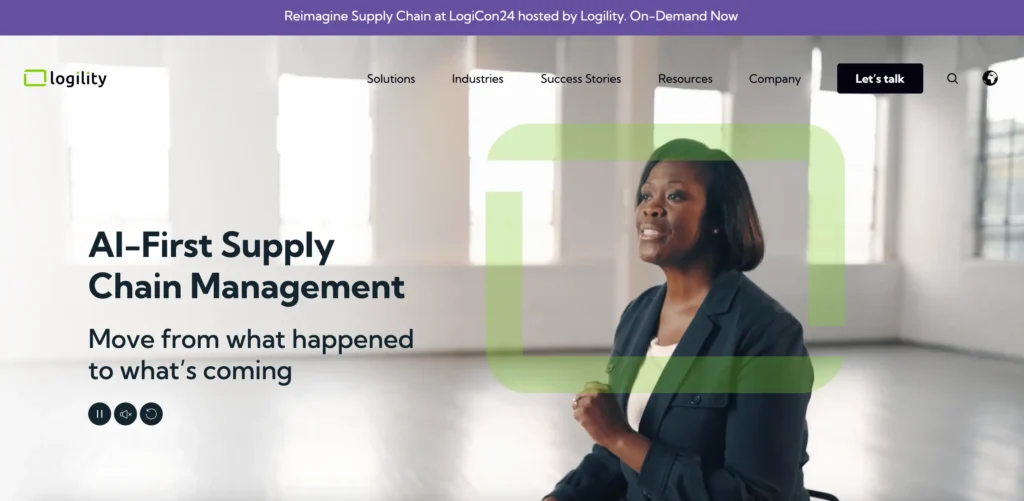
Key Features:
- AI-Driven Demand Planning: Uses machine learning to predict market demand, manage product lifecycles, and optimize promotions for accurate forecasting.
- Inventory Optimization: Multi-echelon inventory tools help set targets, reduce costs, and balance service levels by modeling strategies like postponement and phased inventory.
- Real-Time Collaboration: Facilitates cross-team coordination with real-time data sharing and alignment in supply chain planning and execution.
- Scenario Planning and Analytics: Enables businesses to simulate supply chain scenarios, assess risks, and make data-backed decisions for improved agility.
Limitations:
- Complexity for New Users: Advanced tools like AI-driven analytics and scenario planning require significant training, making onboarding challenging for teams
- Integration Limitations with Large Data: Struggles with processing large data sets and integrating with existing systems can slow real-time planning in complex networks
Ratings (as of December, 2024):
- G2: 4.1/5
- Gartner: 4.6/5
Testimonials:
“Had some functionality that was rated out of scope after we were too far into the project to go another direction. Had several SOWs to pay after initial negotiations. But delivered on time.”
4. Coupa
Coupa’s Supply Chain Design & Planning software, powered by LLamasoft, helps businesses optimize their supply chain by using AI-driven solutions. The platform allows users to build digital models of their supply chains and run unlimited scenarios to balance trade-offs and make informed decisions. Coupa’s network optimization and inventory management capabilities enable companies to improve cost efficiency, sustainability, and resilience across their supply chains.
With Coupa, organizations can leverage demand modeling, transportation optimization, and AI-driven insights to respond to market shifts and supply chain disruptions more effectively. The platform’s flexibility enables fast scenario testing, giving businesses the tools to design cost-effective, adaptive supply networks that align with their strategic goals.
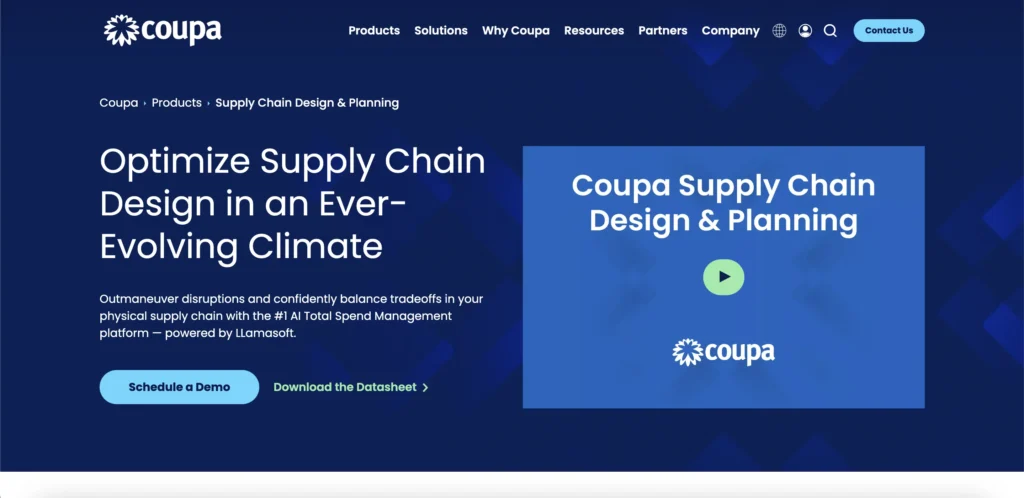
Key Features:
- AI-Driven Cost Optimization: Leverages AI and machine learning to identify cost-saving opportunities and optimize supply chain strategies.
- Network and Location Optimization: Helps evaluate and refine the placement of manufacturing facilities, warehouses, and transportation routes to improve efficiency.
- Scenario Optimization with Digital Twin Technology: Uses digital twin technology and advanced analytics to model supply chain scenarios, enabling businesses to compare current and proposed networks side by side.
- Sustainability and Risk Analysis: Analyzes the effects of climate on supply chain operations, identifies vulnerabilities, and helps optimize for cost, service, and carbon reduction.
Limitations:
- Steep Learning Curve: Coupa’s system requires significant time to learn, especially for new users or administrators, with modules like Risk and Sourcing being challenging to configure.
- Customer Support and Functionality Limitations: Post-acquisition, customer support quality has declined, and certain features, such as cXML invoicing and catalog management, lack sufficient functionality.
Ratings (as of December, 2024):
- G2: 4.2/5
- Gartner: 4.7/5
Testimonials:
“Ease of communication amongst multiple different customers. Lack of ability to communicate with all other software working in.”
5. E2Open
E2Open provides a comprehensive supply chain planning software designed to optimize performance and resilience across complex, multi-tier supply chains. The platform leverages AI-driven insights to create fast, feasible, and profitable plans while enhancing collaboration across trading partners. It enables businesses to anticipate customer demand, optimize inventory, and address bottlenecks with real-time supply signals.
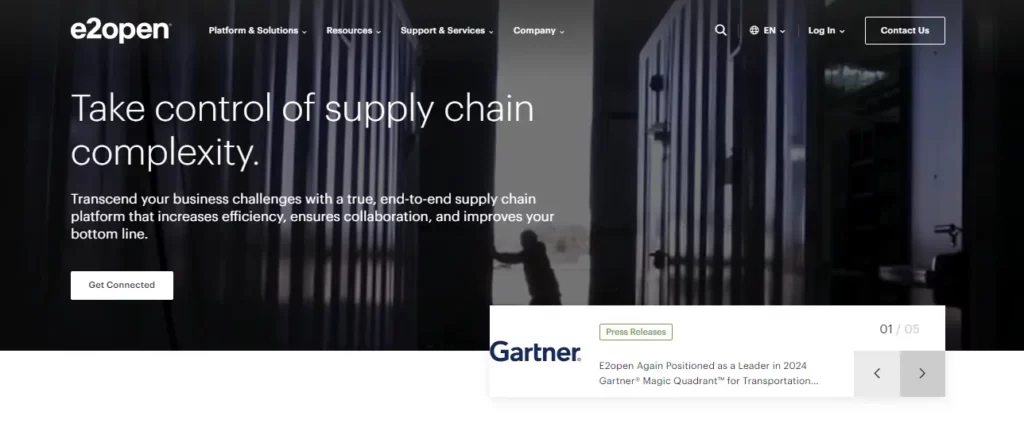
Key Features:
- Collaborative Network: Connects businesses with a vast network of 480,000 manufacturers, distributors, and logistics providers, enabling seamless collaboration across the supply chain.
- Predictive ETAs and Real-Time Tracking: Offers predictive estimated times of arrival (ETAs) and provides real-time shipment tracking across all transportation modes.
- Simplified Shipment Management: Consolidates all shipment bookings into a single platform, streamlining the process and improving efficiency.
- Carrier Invoice Comparison and Cost Reduction: Allows businesses to compare carrier invoices, simplifying contracts and lowering logistics costs.
Limitations:
- Steep Learning Curve: E2Open’s features can be challenging for new users, requiring significant time and training to fully utilize the platform.
- Integration Difficulties: Integrating E2Open with legacy systems or third-party tools can be complex, causing delays in streamlining workflows.
Ratings (as of December, 2024):
- G2: 4.1/5
- Gartner: 4.3/5
Testimonials:
“A system that can manage all your rates, carrier, and spend all in 1 system. System doesn’t incorporate ocean freight and air shipment. it’s only on the road truck or rail carriers.”
6. Anaplan
Anaplan is a powerful tool for companies looking for a unified approach to supply chain planning, combining forecasting, inventory management, and production planning in one platform. The software’s analytics and forecasting capabilities allow companies to anticipate demand accurately and plan inventory accordingly.
Anaplan’s strength lies in its real-time data analytics and collaborative platform, which helps teams make decisions faster and stay aligned on supply chain goals. With a simple, user-friendly interface, it’s built to provide insights without overwhelming users, though the initial setup may require some learning.
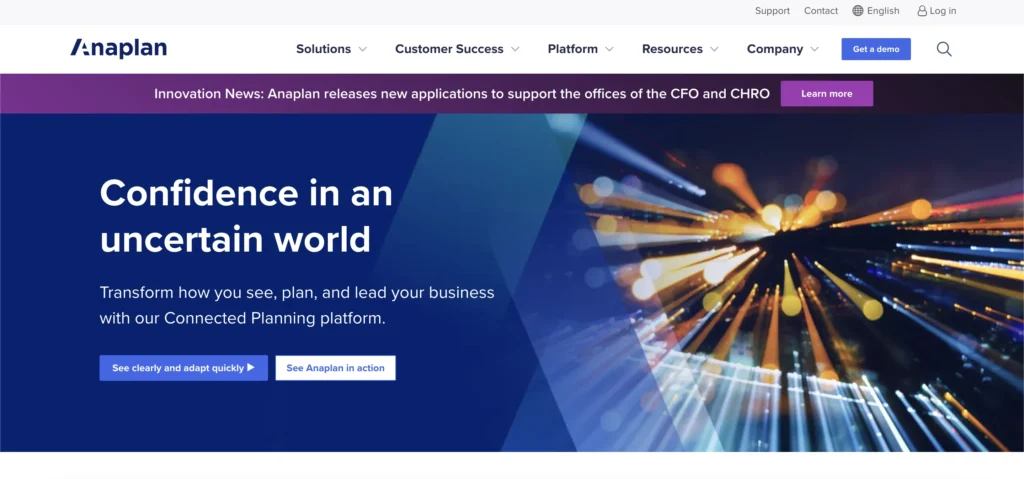
Key Features:
- Real-time Forecasting & Demand Planning: Leverages real-time data to improve demand forecasting accuracy and optimize inventory management.
- Customizable Dashboards: Highly flexible dashboards that allow users to design their views for better insights and data-driven decisions.
- Scenario Planning: Enables businesses to create multiple “what-if” scenarios, allowing for agile responses to market changes or disruptions.
- Cross-functional Integration: Facilitates collaboration across departments, integrating finance, supply chain, and operations for seamless decision-making.
Limitations:
- Costly for Small Businesses: Anaplan’s pricing model may be prohibitive for smaller companies with limited budgets.
- Learning Curve: The platform’s vast array of features can be overwhelming, requiring significant time for training and onboarding.
Ratings (as of December, 2024):
- G2: 4.6/5
- Capterra: 4.5/5
Testimonials:
“The platform is very good but we do not receive the support we need or it takes time for them to respond to our concerns. Also, when we requested for model performance analysis, the analysis provided to us was at surface-level or things that we already know how to fix. ”
7. Blue Ridge Global
Blue Ridge Global is a dedicated solution for companies that require precise demand forecasting and inventory optimization. It leverages advanced algorithms and machine learning to analyze demand patterns and provide accurate stock recommendations, reducing excess inventory and ensuring adequate supply. Designed for flexibility, Blue Ridge adapts well to changing demand, making it a reliable partner for businesses needing robust inventory planning tools.
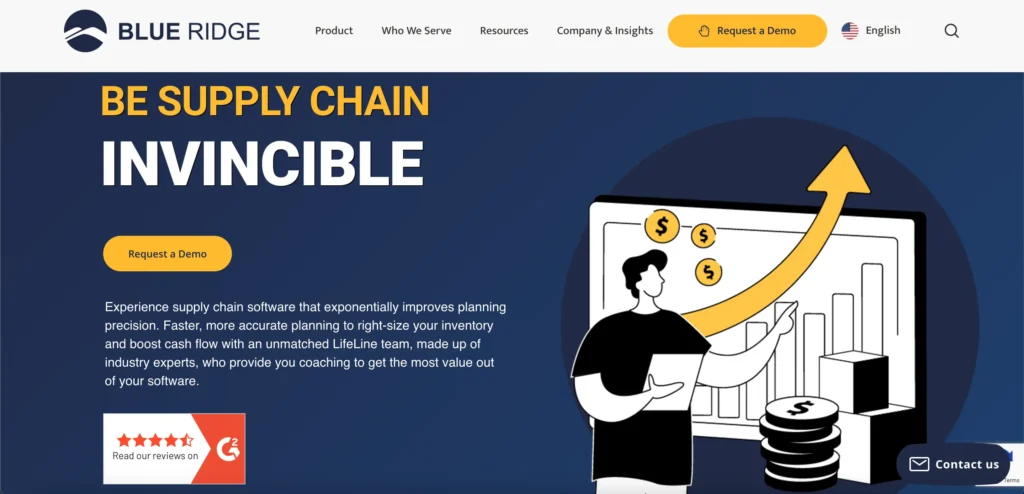
Key Features:
- Machine Learning-Based Demand Forecasting: Advanced algorithms help predict demand trends with high accuracy, reducing stockouts and overstocking.
- Automated Inventory Optimization: Streamlines inventory replenishment, ensuring stock levels are always aligned with demand forecasts.
- Advanced Analytics for Supply Chain Insights: Provides actionable insights and metrics to help businesses make data-driven decisions for better inventory management.
- Seamless ERP Integration: Effortlessly integrates with existing ERP systems for smoother data flows and improved operational visibility.
Limitations:
- Dependency on Historical Data: Blue Ridge relies heavily on historical data for forecasting, which can be less effective in rapidly changing markets.
- Implementation Time: Setting up and fully implementing the software can take time, potentially delaying its benefits.
Ratings (as of December, 2024):
- G2: 4.7/5
- Capterra: 4.9/5
Testimonials:
“Blue Ridge has brought our purchasing department to the next level. Lowered inventory levels, lowered carrying costs, increased fill rates and increased inventory turns. Customer support (Lifeline) is a huge plus, they are always very responsive to our needs. Some newly introduced features may be buggy, but nothing major.”
8. Board
Board is an all-in-one planning platform that combines strategy, finance, and supply chain planning in one. Used by global enterprises, it offers a visual, user-friendly interface for planning processes from goal setting to execution. Key features include customizable dashboards for scenario analysis and performance tracking, giving businesses a complete view of their supply chain operations. Board’s integration capabilities also allow teams to align their supply chain strategies with financial and operational goals for a streamlined approach to planning.
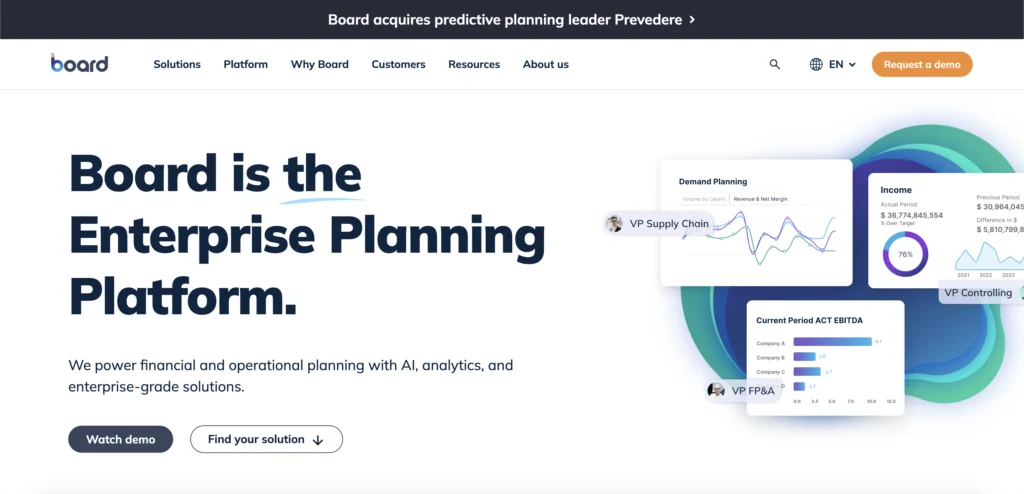
Key Features:
- Multi-Functional Planning Capabilities: Combines strategy, finance, and supply chain operations in one platform for holistic business planning.
- Customizable Dashboards & KPIs: Tailor the system to display the most relevant metrics for your business, helping to track performance across multiple functions.
- Scenario Analysis & Simulation: Evaluate different scenarios with ease, helping your business to stay agile and prepared for market changes.
- Centralized Data Analytics: Unifies data from various sources into a single, accessible location, improving cross-departmental collaboration and reporting accuracy.
Limitations:
- Complex Setup & Learning Curve: Board requires a steep learning curve, especially for beginners, with many users needing external support to set up and integrate the platform effectively.
- Limited Visibility in Calculations: While Board is powerful for creating calculations, it lacks transparency on intermediary steps, making it difficult for users to track or debug their work during development.
Ratings (as of December, 2024):
- G2: 4.4/5
- Capterra: 4.5/5
Testimonials:
“The tool itself has been great – implementation had its hiccups as they outsourced us to outside consultants and we had to start from scratch on scoping.”
9. Solvoyo
Solvoyo offers a high-tech, AI-driven platform for demand forecasting, transportation planning, and network design. Its advanced algorithms analyze supply chain data to provide accurate forecasts, optimize logistics, and improve route planning. Solvoyo’s intuitive design makes it user-friendly, allowing supply chain teams to make informed decisions quickly. With a focus on efficiency, Solvoyo provides tools to help companies reduce costs, streamline logistics, and respond flexibly to changes in demand.
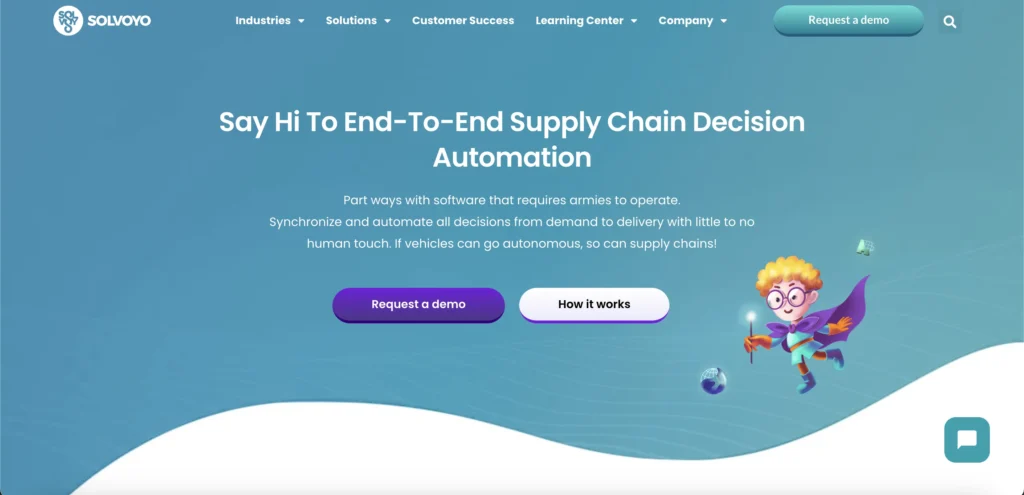
Key Features:
- AI-Driven Demand Forecasting: Uses advanced AI to deliver highly accurate demand forecasts, improving supply chain decision-making.
- Real-time Data Analytics: Continuously monitors operations and provides instant insights for quick adjustments to supply chain activities.
- Automation in Replenishment & Inventory Management: Automates stock replenishment, ensuring that inventory levels remain optimal without manual intervention.
- End-to-End Supply Chain Visibility: Offers a full view of the supply chain from planning to execution, allowing businesses to make proactive adjustments.
Limitations:
- Complex Integration: Solvoyo’s integration with existing systems, such as ERP platforms, can be complex and require technical expertise.
- User Interface: Some users may find the interface less intuitive compared to other platforms, which may require additional training.
Ratings (as of December, 2024):
- G2: 4.5/5
- Capterra: 4.6/5
Testimonials:
“Solvoyo has transformed our supply chain with its automated processes and real-time analytics, giving us better visibility and control over our operations.”
10. StockIQ
StockIQ is tailored for demand forecasting, inventory planning, and replenishment optimization across the supply chain. Known for its intuitive dashboard, StockIQ helps supply chain managers make accurate predictions based on historical data and market trends, reducing overstock and stockouts.
With its collaborative tools, StockIQ fosters teamwork by making data accessible across departments. It’s particularly popular with distributors and manufacturers who need reliable inventory and demand management capabilities.
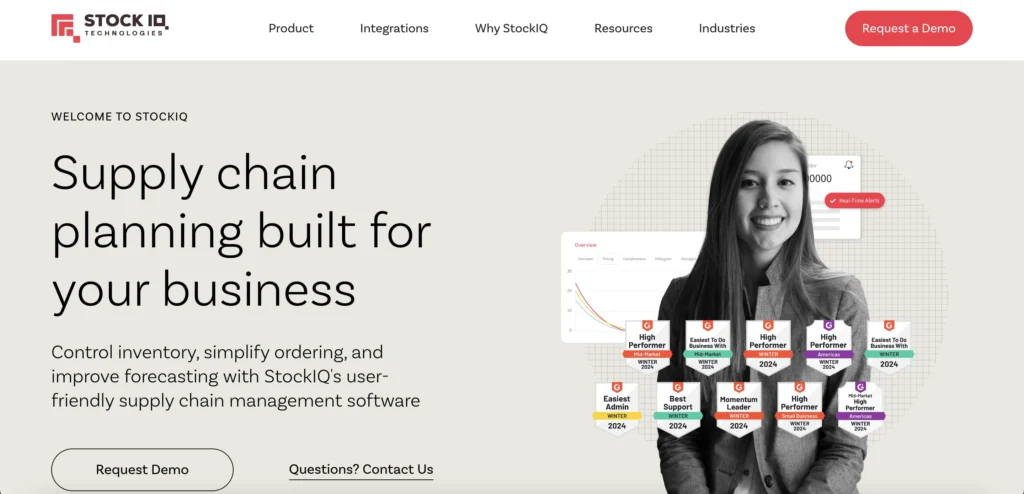
Key Features:
- Demand Forecasting & Inventory Optimization: Advanced tools to predict demand and adjust inventory levels accordingly to avoid overstocking or stockouts.
- Multi-location Inventory Control: Enables businesses to manage inventory across multiple warehouses and locations efficiently.
- Supplier Performance Monitoring: Tracks supplier performance metrics, ensuring timely deliveries and optimal supplier relationships.
- Automated Replenishment & Order Management: Streamlines the replenishment process, minimizing manual errors and improving order accuracy.
Limitations:
- Limited Scalability: While effective for smaller to mid-sized businesses, StockIQ may face limitations as organizations scale and require more advanced functionalities.
- Dependence on Accurate Data: Like many demand forecasting tools, StockIQ’s predictions rely heavily on high-quality, accurate data input.
Ratings (as of December, 2024):
- G2: 4.6/5
- Capterra: 4.7/5
Testimonials:
“SIQ is easy to learn and intuitive to use. Their development team makes smart software updates and seek user feedback to make the experience and tools more functional and under-friendly. It would be nice if there is an icon or marker showing if a product has a model adjustment on a forecast that might affect normal SIQ algorithms. It’s difficult to see these are in effect when managing many SKUs.”
11. O9 Solutions
O9 Solutions is a powerful AI-driven platform designed for integrated planning across demand, supply, and financial operations. Its end-to-end visibility allows companies to see the entire supply chain and make data-driven decisions. The software offers scenario planning and real-time analytics, which help teams assess different situations and respond to changing demands.
The platform is versatile, adapting to the unique needs of industries like retail, consumer goods, and manufacturing. With its robust features, O9 Solutions is best for organizations looking to enhance visibility and connect supply chain planning with business goals.
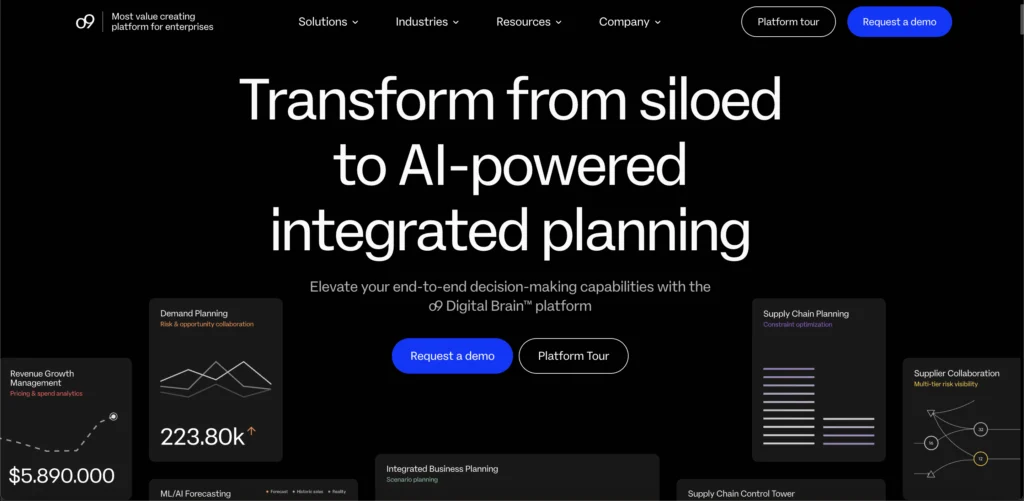
Key Features:
- AI-Powered Demand and Supply Planning: Uses artificial intelligence to optimize demand and supply forecasting, improving planning accuracy and responsiveness.
- Real-time Scenario Modeling: Quickly simulates various scenarios to assess the impact of changes in demand, supply, or other variables on your supply chain
- Integrated Business Planning: Connects supply chain planning with financial and operational goals, ensuring all departments are aligned.
- Predictive Analytics: Uses machine learning to identify patterns and predict future trends, helping businesses stay ahead of the curve.
Limitations:
- Implementation Complexity: The platform’s broad range of features and integrations can result in a lengthy and complex implementation process.
Ratings (as of December, 2024):
- G2: 4.6/5
- Capterra: 4.8/5
Testimonials:
“With O9 Solutions, we’ve improved our planning accuracy significantly, and the scenario modeling feature has been a game-changer for quick decision-making.”
12. Arkieva
Arkieva is a sophisticated tool for supply chain optimization, covering everything from demand planning to inventory and production scheduling. Designed for large enterprises, Arkieva uses machine learning and predictive analytics to improve supply chain decisions and adapt to changing demand patterns.
Its real-time data insights give supply chain managers a complete view of operations, enabling them to make proactive adjustments. Arkieva’s focus on aligning demand and production makes it a solid choice for manufacturing and large-scale distribution businesses.
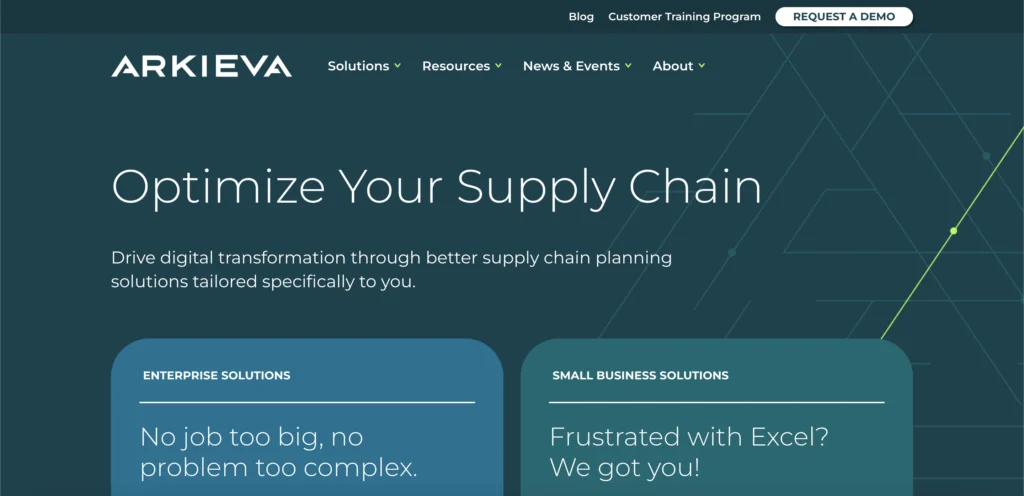
Key Features:
- S&OP Integration for Cross-Functional Planning: Supports integrated business planning (IBP) by aligning sales, operations, and financial planning for seamless collaboration across departments.
- Advanced Demand & Inventory Planning: Provides advanced tools for demand forecasting and inventory management, helping to optimize stock levels and reduce excess inventory.
- Predictive Analytics for Scenario Planning: Uses predictive analytics to simulate future scenarios, allowing businesses to adapt quickly to changing conditions.
- Customizable Workflows & Dashboards: Offers flexibility to create workflows and dashboards tailored to your unique business needs.
Limitations:
- Limited Reporting Features: Arkieva’s reporting capabilities might not be as comprehensive as those offered by some competing platforms.
- User Experience: The platform’s user interface can feel less modern, with some users finding it less intuitive than other options on the market.
Ratings (as of December, 2024):
- G2: 4.4/5
- Capterra: 4.6/5
Testimonials:
“Good for Demand planning and forecasting. Integration capabilities need to evolve and support system has to improved”
Conclusion
Selecting the best supply chain planning software can streamline operations, reduce costs, and improve customer satisfaction. Each of the software options reviewed here provides unique features, so consider what matters most to your business to find the best fit.



